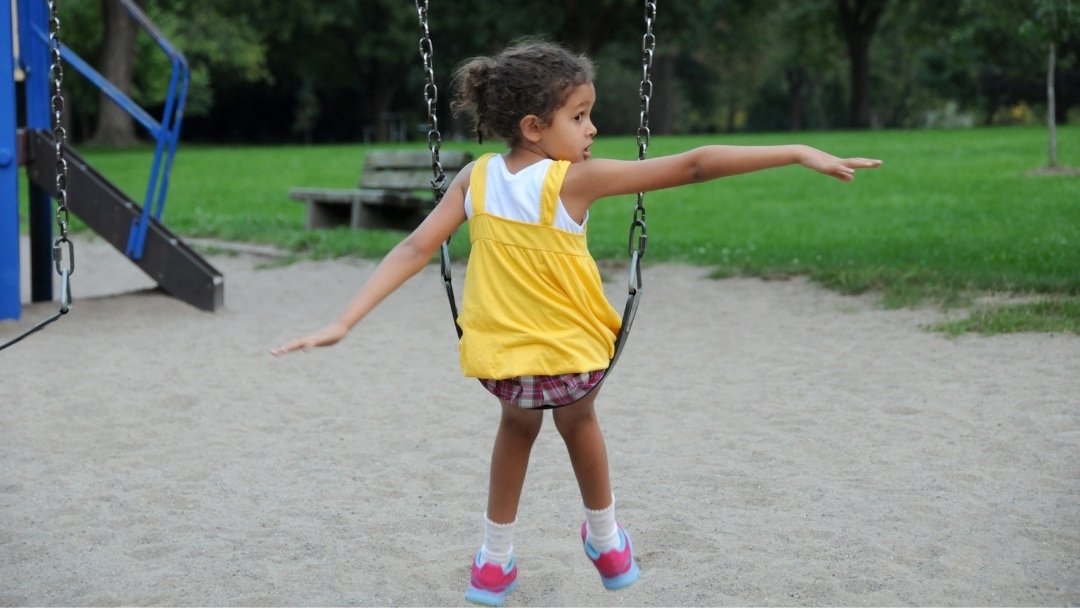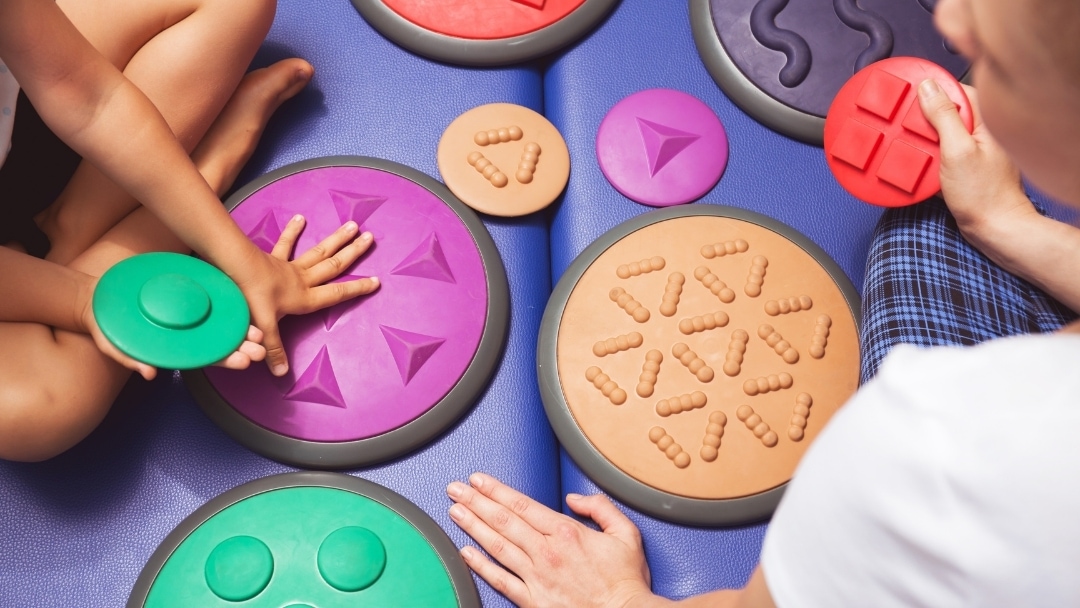In this blog post, Bonnie Hanschu OTR and Myania Moses OT explain what a sensory diet is and how to incorporate it into everyday life.
What helps you get started in the morning? Hot shower? Cold shower? Your regular exercise routine or morning run? Quiet time? Music? All these activities provide sensory stimulation to the nervous system in the same way that food provides nourishment to the body.
Some sensory input such as clapping is like a snack, low intensity and short duration. Swinging is more like a meal, higher in intensity and longer lasting. A good sensory diet provides the combination of input needed for peak performance from the time we wake up until we go to bed.
A sensory diet can help many individuals with autism, whose sensory processing is compromised, because they may find it hard to achieve and maintain an appropriate arousal level. In addition, a sensory diet can help those with Sensory Processing Disorder, as well as those with ADD/ADHD and learning disabilities; sensory issues may be playing a large, undetected role in these disorders. Children with these disorders may move from sensory-seeking to sensory-avoidance behaviors, which can be problematic for authority figures even though they serve a purpose for the individual.
But what if kids with autism and other neurodevelopmental disorders were given opportunities to rock, touch, move, and jump? Maybe they would be satiated and not act out inappropriately.
What Is a Sensory Diet?
Sensation stimulates a primitive part of the brain, known as the brain stem, which responds to touch, movement, and muscle action by releasing chemicals that wake us up or calm us down. Everything we do, think, or feel is possible because of the automatic modulating activity of the brain stem to keep us at an appropriate level of arousal. A varied sensory diet helps us achieve all the different brain states we experience in a typical day, e.g., happy but focused, relaxed but serious, alert and ready to act.
Normally, the brain stem adjusts the chemistry automatically so we keep up with the flow of our experience. When the chemistry falls behind, we may feel sluggish or too revved. We might have trouble concentrating or notice irrelevant things, like the feel of our clothing or outside noises, when we are inside trying to read. Somehow we’re “off.” We may feel out-of-sync or look that way to others.
When this happens, we need to so something physical: stand up, stretch, or move around. Physical activities enrich our sensory input, enabling our brain stems to activate more effective chemical combinations for what we are experiencing.
With good modulation, children can be automatically appropriate in the degree and timing of their responses. Compromised sensory processing makes it hard to achieve and maintain an appropriate arousal level. There’s usually too little or too much arousal to fit the situation.
No matter how hard children with this problem try, they can’t keep pace with changes, transitions, interruptions, or lots of things going on at the same time. Modulation difficulties interfere with attention and ability to learn and sometimes escalate to the point where children completely lose control.
It helps when adults who care for children are mindful of the sensory demands associated with different experiences and respect the sensory preferences and idiosyncrasies of individual children. Professionals and parents who understand how sensation influences brain efficiency can tweak daily routines to provide a varied and appetizing sensory diet.
This is the stance taken by many occupational therapists who show parents how to use a sensory diet. Just as a nutritionist recommends certain foods and supplements, the occupational therapist may recommend readily available opportunities to be physical, and supplements them with a prescription of the “just right” combination of sensory activities for a particular child. Essential ingredients of a rich sensory diet are:
- Heavy work
- Physical activity
- Muscle exertion
- Movement
- Firm, comforting touch
A good sensory diet is food for the nervous system and includes activities such as swinging, climbing, digging, and molding play dough. Including vestibular stimulation activities as part of the daily diet for a child with these disorders can be extremely powerful. Working against gravity on suspended equipment could result in secondary gains in the crucial areas of digestion, visual function (including eye contact), communication, and socialization.
Incorporating a Sensory Diet
Here are some ways to give kids of all ages and abilities more sensory experiences throughout the day:
Modify Routine Activities
- Add weight
- Move things out of reach
- Go the longer way over uneven terrain
- Put pressure on shoulders to activate neck receptors for proprioception while walking
- Give tighter hugs
Modify Objects to Increase Sensory Demands
- Provide obstacles to climb over, crawl under, or walk around
- Make door catches tighter so one has to pull or push harder
- Use objects of differing sizes and weights to require frequent readjustment of exertion
- Offer larger versions of tasks, such as writing on a chalkboard instead of paper
Create New Opportunities
- Take breaks for moving, pushing, or pulling
- Wrap ace bandages around limbs for extra touch pressure
- Do isometric exercises and chair push-ups
- Do Brain Gym® before challenging activities
- Sit quietly to settle down after excitement, while hugging knees and taking deep breaths
Add Sensation to a Non-Sensory Activity
- Review academics while swinging or while balancing on a T-stool
- Answer questions while pushing or pulling
- Sit on a vibrating pad or slightly inflated ball while reading or taking a test
Create a Sensory Room
For many kids with sensory disorders, the world feels just too loud and too bright; they need a refuge to which they can escape and get their balanced diet of sensory stimuli. Several companies now offer free design services for schools and families to create rooms that can be customized to individuals’ unique sensory needs. Experia USA offers equipment such as:
- Bubble tubes
- Fiber optics
- Sound boards
- Mirrors
- Interactive microphones
- Equipment for developing:
- Vocalization
- Gross motor skills
- Color recognition
- Tracking
- Calming
Their products include sensory bathrooms, bedrooms and even sensory white rooms.
Environmental Changes That Enhance Sensory Processing
Many modifications of the classroom environment will enhance the ability of all students. Consider the following:
Ensure Quality Lighting
Natural light is best; full spectrum bulbs help. Fluorescent lighting is the least desirable.
Decrease Visual “Busyness” of Room and Written Work
For students with autism, avoid mobiles, venetian blinds, wallpaper, and clutter; they are all distractors. Make sure photocopied materials are fully legible.
Provide Seating Options
Some kids do better on special cushions and beanbag chairs than on hard, ill-fitting, unforgiving wooden chairs. Make sure that the table or desk is not too high or low, so that both feet fully touch the floor and the child’s lap is at a right angle.
Allow Breaks
When children can move around, they also have the opportunity to rest their eyes.
Conclusion
A rich sensory diet can make a big difference in how everyone experiences and relates to the world. A balanced “meal” of sensation could leave students with sensory needs feeling replenished, settled, organized and empowered.
Still Looking for Answers?
Visit the Epidemic Answers Practitioner Directory to find a practitioner near you.
Join us inside our online membership community for parents, Healing Together, where you’ll find even more healing resources, expert guidance, and a community to support you every step of your child’s healing journey.
Sources & References
Mumford R. Improving Visual Efficiency with Selected Lighting. JOVD, 2002, 33:3.




